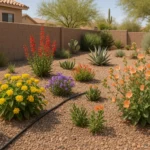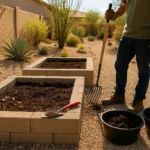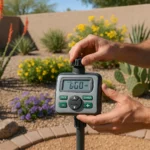As February gives way to March, Gilbert yards begin their transformation. The subtle shift in temperature signals it’s time to prepare for the vibrant spring season ahead. While much of the country remains blanketed in snow, our unique desert climate offers the perfect opportunity to get ahead on yard care before the summer heat arrives. For Gilbert homeowners, these early spring weeks are crucial for setting up a thriving outdoor space that can withstand Arizona’s challenging seasons.
March Calendar: Your Gilbert Spring Yard Care Timeline
Early spring in Gilbert requires a systematic approach to yard care. Consider this your March calendar for optimal results:
Week 1 (March 1-7): Conduct a thorough yard assessment. Walk your property noting winter damage, irrigation issues, and areas needing attention. Test your irrigation system for leaks or clogs. This is also the ideal time to send soil samples for testing if you’ve noticed previous growing challenges.
Week 2 (March 8-14): Focus on cleanup and preparation. Remove debris, trim back frost-damaged plants, and prepare garden beds. This is the perfect window to apply pre-emergent herbicides before weed seeds germinate. For Bermuda grass lawns, begin gradually lowering your mowing height to encourage spring green-up.
Week 3 (March 15-21): Implement your fertilization plan based on soil test results. For most Gilbert lawns, a balanced spring fertilizer with nitrogen will support healthy growth. This week is also ideal for planting summer-flowering bulbs and refreshing mulch around trees and garden beds.
Week 4 (March 22-31): Complete any remaining spring pruning and begin your regular watering schedule adjustments as temperatures rise. Monitor newly planted areas closely and prepare for April’s growing season by finalizing your garden plan.
Navigating Gilbert’s Unique Spring Climate Challenges
Gilbert’s spring presents distinct challenges for yard care enthusiasts. Our transitional season can bring unexpected temperature fluctuations, with daytime highs sometimes reaching the 80s while nighttime temperatures occasionally dip into the 40s. This temperature swing requires strategic plant protection and irrigation management.
Our spring also arrives earlier than in most parts of the country. While friends and family in northern states might still be shoveling snow, Gilbert residents are already dealing with active growth and early blooms. This head start means we need to be proactive about fertilization, weed control, and irrigation adjustments before many gardening calendars even mark the beginning of spring.
Another consideration is our decreasing humidity levels as spring progresses. While early March might bring occasional moisture, late spring typically sees dramatically drier conditions. This transition period requires gradually increasing watering frequency and depth, particularly for non-native plants that haven’t adapted to our desert conditions. Consider grouping plants with similar water needs together to maximize irrigation efficiency.
Preparing Your Irrigation System for Spring Success
Your irrigation system requires special attention during Gilbert’s spring transition. Begin by conducting a thorough inspection of all components. Check for leaks, clogs, or damage that may have occurred during winter. Run each zone briefly to ensure proper coverage and look for sprinkler heads that need adjustment or replacement. This is also the perfect time to clean filters and pressure regulators to ensure optimal performance.
As temperatures rise throughout spring, your watering schedule will need regular adjustments. Early March typically requires watering established desert-adapted trees and shrubs about once every 14 days. By late April, this might increase to every 7-10 days depending on temperature and rainfall. Lawns will need more frequent attention, starting with twice weekly watering in early spring and potentially increasing to three times weekly by late spring.
Consider upgrading to a smart irrigation controller if you haven’t already. These systems can automatically adjust watering schedules based on local weather conditions, saving both water and money. Many Gilbert residents find that these controllers pay for themselves within a season through reduced water bills and healthier plants. The Town of Gilbert occasionally offers rebates for water-saving irrigation upgrades, so check their website for current programs.
Lawn Revival: Bringing Bermuda Grass Back from Dormancy
For Gilbert homeowners with Bermuda grass lawns, spring represents a critical transition period. As soil temperatures consistently reach above 65°F, Bermuda grass begins emerging from winter dormancy. This process requires specific care to ensure a healthy, vigorous lawn throughout the growing season. Start by gradually lowering your mowing height in early March, removing no more than one-third of the blade length at each mowing. This encourages lateral growth and helps prevent scalping when you reach your summer maintenance height.
March is also the ideal time to address soil compaction issues in your lawn. Consider aerating if your soil feels dense or if water tends to run off rather than soak in. Core aeration removes small plugs of soil, allowing better water penetration, root growth, and nutrient absorption. For best results, aerate when your Bermuda grass shows signs of active growth but before the intense heat of late spring arrives.
Fertilization timing is crucial for Bermuda grass revival. Wait until you see consistent greening across at least 50% of your lawn before applying your first spring fertilizer. Applying too early wastes nutrients and can contribute to water pollution through runoff. Choose a balanced fertilizer with a nitrogen emphasis, following package directions for application rates. If you’re unsure about your soil’s specific needs, the results from a soil test can provide valuable guidance for fertilizer selection.
Early Bloomers: Nurturing Gilbert’s Spring Flowers
Gilbert’s warm spring temperatures create the perfect environment for early-blooming plants. Desert marigold, penstemon, and brittlebush typically lead the spring show with vibrant yellows, purples, and oranges. To maximize their impact, remove spent winter annuals by mid-March and prepare beds for new plantings. When selecting spring flowers, consider both immediate color and heat tolerance for extended bloom periods. Good choices include lantana, verbena, and angelita daisy, which provide color while transitioning well into summer.
For container gardens, spring offers an opportunity to refresh and replant. Clean containers thoroughly, replace depleted potting soil, and ensure adequate drainage before planting. Consider creating “thriller, filler, spiller” combinations with vertical elements (thrillers), mid-height plants (fillers), and trailing varieties (spillers). Desert-adapted options like trailing rosemary, compact penstemons, and ornamental grasses work beautifully together while handling Gilbert’s spring conditions.
Don’t overlook spring-blooming bulbs and tubers for your Gilbert garden. While many traditional spring bulbs require winter chilling that our climate doesn’t provide, alternatives like amaryllis, canna lilies, and certain dahlia varieties thrive in our conditions when planted in early spring. These plants add dramatic vertical elements and unique flowers to your landscape while establishing themselves before summer heat arrives. Provide regular water during their establishment period, gradually reducing frequency as they mature.
Managing Spring Weeds in Gilbert Yards
Spring brings renewed weed activity across Gilbert, making early intervention essential. Pre-emergent herbicides should be applied by early March before soil temperatures consistently reach 55°F and weed seeds germinate. For established Bermuda lawns, products containing pendimethalin or prodiamine provide effective control when applied according to label directions. Remember that pre-emergents create a barrier that prevents seed germination, so timing is crucial for effectiveness.
For landscape beds and hardscaped areas, consider applying a pre-emergent herbicide specifically formulated for these zones. These typically come in granular form and require watering to activate. Refresh mulch layers to a depth of 2-3 inches after application to enhance weed suppression while conserving soil moisture. For rock landscapes, landscape fabric beneath decorative rock provides an additional barrier against persistent weeds.
Despite preventive measures, some weeds inevitably appear. Address them promptly with appropriate post-emergent control methods. For small infestations in landscape beds, hand-pulling remains effective, particularly after irrigation when soil is moist. For lawns, selective herbicides targeting specific weed types can be applied once Bermuda grass shows active growth. Always follow label directions regarding application timing, rates, and temperature restrictions to avoid damaging desirable plants.
Tree and Shrub Care for Gilbert’s Spring Season
Spring presents the ideal opportunity to assess and address the health of your Gilbert landscape’s trees and shrubs. Begin with careful pruning to remove frost damage, crossing branches, or diseased material. For most desert-adapted trees and shrubs, major pruning should be completed by mid-March before the flush of new spring growth. Citrus trees are an exception—delay their pruning until after danger of frost has passed completely, typically late March in Gilbert.
Fertilization needs vary significantly among tree and shrub species. Native desert plants generally require minimal supplemental fertilization, while non-natives and fruit trees benefit from appropriate spring feeding. For citrus trees, apply the first third of their annual fertilizer requirement in February or early March when blossoms appear. Other fruit trees should receive balanced fertilizer just before bud break. Established landscape trees typically need fertilization only every 2-3 years unless soil tests indicate specific deficiencies.
Monitor trees and shrubs closely during spring for pest activity. Aphids often appear on new growth, while scale insects and mites become more active as temperatures rise. Beneficial insects like ladybugs and lacewings provide natural control, so consider their presence before intervening with insecticides. When treatment becomes necessary, horticultural oils and insecticidal soaps offer effective control with minimal environmental impact when applied according to label directions during cooler morning hours.
Preparing for Summer: Strategic Spring Planning
Spring yard care in Gilbert isn’t just about immediate needs—it’s also about preparing for the challenging summer ahead. Use March and April to implement heat-mitigation strategies throughout your landscape. Consider adding shade structures or planting fast-growing native trees on western exposures to reduce afternoon heat gain. Install drip irrigation systems for garden beds and containers to maximize water efficiency during summer’s peak demand.
Evaluate your plant selection with summer survival in mind. Spring nursery visits often tempt us with beautiful blooms, but prioritize heat tolerance and water efficiency in your choices. Plants established during spring have better survival rates during summer than those planted later. Good options include desert spoon, red bird of paradise, and Texas sage, which provide visual interest while handling summer conditions admirably.
Finally, use spring to address structural and hardscape improvements before summer heat makes outdoor projects uncomfortable. Repair irrigation components, refresh decomposed granite pathways, and seal wooden structures while temperatures remain moderate. Consider adding automated systems like smart controllers or moisture sensors that will help maintain your landscape efficiently during summer when outdoor comfort is limited by high temperatures.
Community Resources for Gilbert Gardeners
Gilbert residents have access to excellent local resources for spring yard care guidance. The University of Arizona Cooperative Extension offers Master Gardener plant clinics throughout spring where you can bring plant samples and questions for expert advice. Their Maricopa County plant hotline provides personalized recommendations for specific yard challenges. Take advantage of these free services to address problems before they escalate.
The Town of Gilbert occasionally hosts water conservation workshops specifically targeting efficient landscape practices. These events typically increase during spring months and provide valuable information about irrigation efficiency, appropriate plant selection, and water-saving techniques. Many include free water-saving devices for participants and information about available rebate programs.
Local nurseries like Gilbert’s SummerWinds and nearby Berridge Nurseries offer spring gardening classes tailored to our specific growing conditions. These businesses understand local challenges and typically stock plants appropriate for our climate. Their experienced staff can provide guidance on spring plant selection and care requirements. Many also offer soil testing services to help identify specific amendments needed for your property.





